Illusion news 4
since June 5, 2006
Akiyoshi KITAOKA has won the Gold Prize of the 9th L'ORÉAL Art and Science of Color Prize! <November 10, 2006>
Gold prize by Tini & Einen Miura |
 |
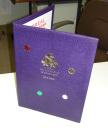 |
 |
Kyoto-shimbun newspaper (in Japanese) <November 8, 2006>
Asahi-shimbun newspaper (in Japanese) <November 8, 2006>
Applicated works, the main: "The four seasons in Japan"
Applicated works, the auxiliary: "Illusion design 'Lipsticks'"
Applicated 'paper': "The effect of color on the optimized Fraser-Wilcox illusion"
(MS-Word file, 75MB)
Thank you for the referees!
Memorial Talk of the Gold
Prize of the 9th L'ORÉAL
Art and Science of Color Prize
Izumi Garden Gallery;
December 1, 2006
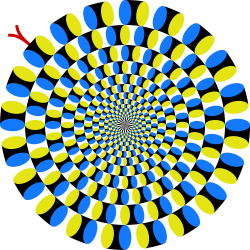
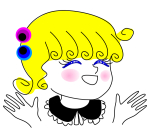
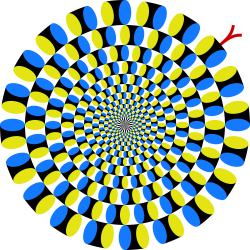
The relationship between the "Rotating snakes" illusion and age has been suspected. I examined this point in a lecture entitled "Visual Illusion" invited by a series of lectures for the citizens of Osaka held at the Osaka City Air Terminal on 21st October, 2006. Forty-seven citizens participated. The age ranged between 21 and 77. The items for answer were "Rotating snakes appear to move well" (score 3), "Rotating snakes appear to move" (score 2), "Rotating snakes appear to move slightly" (score 1), and "Rotating snakes do not appear to move at all" (score 0). As a result, only two observers reported no illusory motion. These observers were over 60 years old. A weak but significant negative correlation between illusion and age was found (p < .05). This result agrees with the survey in VSS2005, USA (May, 2005) while does not with the previous examination in the University of the Air, Japan (December 2005). I guess that the latter examined too small number of observers (n = 25). To sum up, the hypothesis (proposed by Professor Stuart Anstis) that the higher the age the weaker the Rotating snakes has been accepted while the correlation is rather weak. <October 24, 2006>
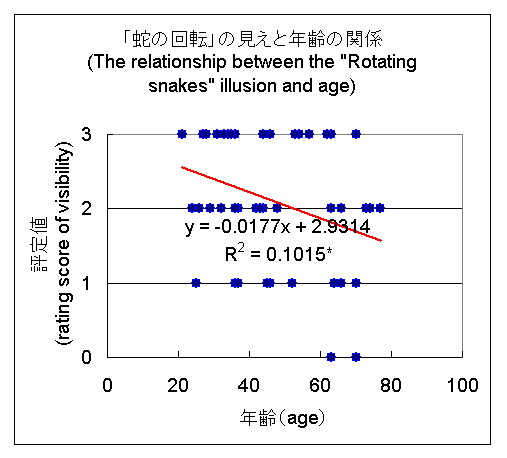
My books "Trick Eyes" and "Trick Eyes Graphics" has been reviewed by Professor Richard Gregory in Perception (Pion Ltd., London)!! <October 9, 2006>
Gregory R, 2006 "Reviews, Gregory on Kitaoka: Trick eyes: Magical illusions that will activate the brain, and Trick eyes graphics" Perception 35 999 PDF (through IP authorization from Perception)
Our review paper on the visual phantom illusion has been published! <October 7, 2006>
Kitaoka, A., Gyoba, J., and Sakurai, K. (2006) Chapter 13 The visual phantom illusion: a perceptual product of surface completion depending on brightness and contrast. Progress in Brain Research, 154 (Visual Perception Part 1), 247-262. PubMed PBR
Reprints are available now (after October 24, 2006). Please email me your reprint request. It seems that PDF is not available.
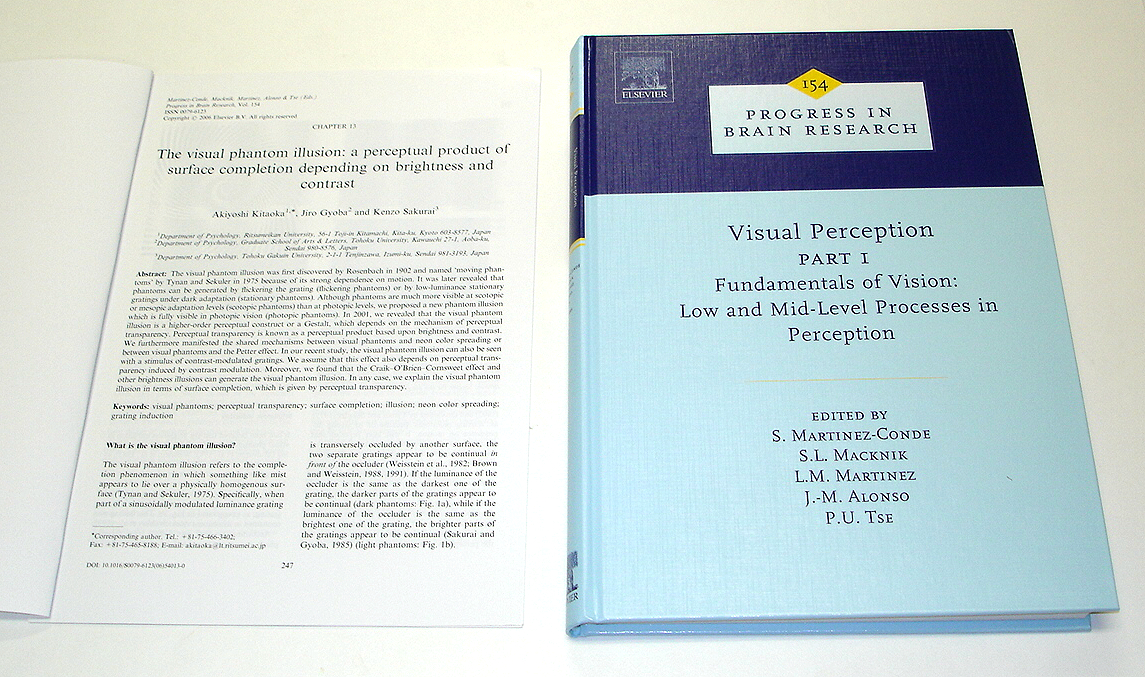
****CALL FOR ILLUSION SUBMISSIONS: THE THIRD ANNUAL BEST VISUAL ILLUSION
OF THE YEAR CONTEST**** <September 25, 2006>
http://illusioncontest.neuralcorrelate.com
Dear “Best Visual Illusion of the Year” Contestant,
*** We are happy to announce the world’s 3rd annual Best Visual Illusion of the Year Contest!!*** The deadline for illusion submissions is February 15th, 2007!
The 2007 contest will be held in Sarasota, Florida (Van Wezel Performing Arts Hall) on Saturday, May 12th, 2007, during the week of the Vision Sciences Society (VSS) conference.
The 2006 annual contest, also held In Sarasota, Florida, was a huge success, which drew numerous accolades from attendees as well as international media coverage. The First, Second and Third Prize winners were Max Dursteler (Universitätsspital Zürich, Switzerland), Peter Tse (Dartmouth College, USA), and Gideon Caplovitz & Peter Tse (Dartmouth College, USA). To see the illusions, photo galleries and other highlights from the 2006 contest, go to http://illusioncontest.neuralcorrelate.com
Visual Illusion Contestants are invited to submit novel visual or multimodal illusions (unpublished, or published no earlier than 2006) in standard image, movie or html formats. An international panel of impartial judges will rate the submissions and narrow them to the top ten. Then, at the
Contest Gala in Sarasota, the top ten illusionists will present their contributions
and the attendees of the event (that means you!) will vote to pick the
TOP THREE WINNERS!
The renowned sculptor and artist, Guido Moretti, has created three amazing works of art to serve as trophies for the TOP THREE winners!
See the trophies.
Illusions submitted to previous editions of the contest can be re-submitted to the 2007 contest, as long as they meet the above requirements and were not among the top three winners in previous years.
Submissions will be held in strict confidence by the panel of judges and the authors/creators will retain full copyright. No illusions will be posted on the illusion contest’s website without the creators’ explicit permission. As with submitting your work to any scientific conference, participating in to the Best Illusion of the Year Contest does not preclude you from also submitting your work for publication elsewhere.
Submissions can be made to Dr. Susana Martinez-Conde (Illusion Contest
Coordinator, Neural Correlate Society) via email (smart@neuralcorrelate.com) until February 15, 2007. Illusion submissions should come with a (no
more than) one-page description of the illusion and its theoretical underpinnings
(if known). Illusions will be rated according to:
• Significance to our understanding of the visual system • Simplicity of the description • Sheer beauty • Counterintuitive quality • Spectacularity
Visit the illusion contest website for further information and to see last year’s illusions: http://illusioncontest.neuralcorrelate.com
Submit your ideas now and take home this prestigious award!
On behalf of the Neural Correlate Society: Susana Martinez-Conde (Illusion Contest Coordinator)
Neural Correlate Society Executive Committee: Jose-Manuel Alonso, Stephen Macknik, Luis Martinez, Xoana Troncoso, Peter Tse
----------------------------------------------------------------
Susana Martinez-Conde, PhD
Director, Laboratory of Visual Neuroscience
Division of Neurobiology
Barrow Neurological Institute
350 W. Thomas Rd
Phoenix AZ 85013, USA
Phone: +1 (602) 406-3484
Fax: +1 (602) 406-4172
Email: smart@neuralcorrelate.com
http://www.neuralcorrelate.com/smc_lab/
We have talk in ECVP2006 in St Petersburg, Russia, on August 21, 2006. Abstract <August 12, 2006>
Infants see the “Rotating Snake” illusion
S Kanazawa Department of Psychology, Shukutoku University, Chiba, 260-8701 Japan
kanazawa@soc.shukutoku.ac.jp
A Kitaoka Department of Psychology, Ritsumeikan University, Kyoto, Japan
akitaoka@lt.ritsumei.ac.jp
M K Yamaguchi Department of Psychology, Chuo University, Tokyo, Japan
ymasa@tamacc.chuo-u.ac.jp
I am sorry I will be absent in ECVP2006.
Professor Kaoru NOGUCHI, a Gestalt psychologist and a researcher of experimental aesthetics in Japan, passed away on 25th July, 2006, at the age of seventy-one. <July 31, 2006>
His contribution to the study of visual illusion
1. Geometrical illusion, especially further development of the work of
Professor Shiro MORINAGA, his teacher
He classified Morinaga's 'paradoxical' illusions into three categories, one of which is known as the Morinaga misalignment illusion.
Noguchi, K. (1982) The theory of visual illusion: Morinaga'a paradox in positional shifts. Psychology (Tokyo: Science-sha), 29 (Special issue of visual illusion), 40-47 (in Japanese).
2. Proposal of the rule that illusion magnitude positively correlates with the degree of aesthetic feeling
Noguchi, K. and Rentschler, I. (1999) Comparison between geometrical illusion and aesthetic preference. Journal of Faculty of Engineering, Chiba University, 50, 29-33.
I love this paper.
3. His last illusion was a lightness illusion!
A new illusion was proposed in a meeting in Japan! <April 10, 2006>
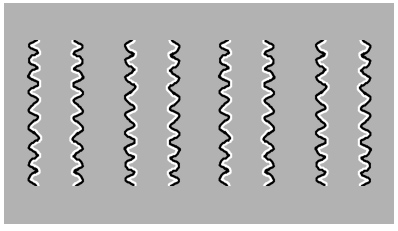
produced by
Midori Takashima 2006 (April 10)
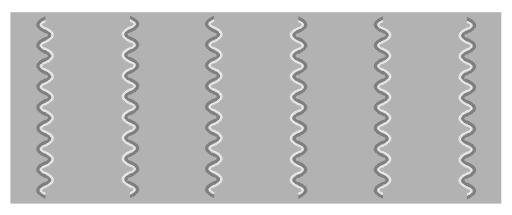
produced by
Akiyoshi Kitaoka 2006 (April 10)
The
Noguchi-Takashima effect (the sumi painting effect)
A new illusion!
The regions surrounded by light borders appear to be lighter than they are while those surrounded by dark borders appear to be darker than they are.
Noguchi, K. and Takashima, M. (2006) "Watercolor effect" and Gestalt factors. Paper published in the 39th Chikaku (Perception) Colloquium (March 23-25, 2006), Takayama-shi, Gifu-ken, Japan.
Akiyoshi's comments: It resembles but is different from the Craik-O'Brien-Cornsweet effect and the watercolor effect. Although Noguchi and Takashima did not claim this effect a new one, I felt that this is quite new, so I persuaded them to give permission to show it in my webpage as a new effect. It should also be noted that the enhancement of brightness induction or filling-in given by the wavy configuration is the invention of Professor Baingio Pinna. Dr. Midori Takashima is a young perceptionist, who was a student of Professor Kaoru Noguchi.
4. He brought up many excellent perceptionists.
Brief Personal History of Professor Kaoru Noguchi
Special field of study:
Perception (Gestalt psychology), Traffic psychology, Psychology of art
Education:
Chiba University, Chiba, Japan
Bachelor of Arts in Psychology, Mar 1957
Tokyo Metropolitan University, Tokyo, Japan
Master of Arts in Psychology, Graduate School of Humanities, Sep. 1960
Work Experience:
Sep. 1961 - Assistant at College of Arts and Sciences, Chiba University, Chiba, Japan
Jan. 1966 - Instructor at College of Arts and Sciences, Chiba University, Chiba, Japan
Oct. 1966 - May. 1968 Research associate at York University Graduate School, York, Canada
Apr. 1968 - Assistant professor at College of Arts and Sciences Chiba University, Chiba, Japan
Dec. 1979 - Professor at College of Arts and Sciences, ChibaUniversity, Chiba, Japan
Jun. 1980 - Aug. 1980 Visiting Scientist at Ludwig Maximilians Universität, Munich, Bundesrepublik of Deutchland
Sep. 1980 - Nov. 1980 Visiting professor at University of Trieste, Trieste, Italy
Apr. 1994 Transfer to Faculty of Engineering, Chiba University, Chiba, Japan
Sep 1999 Retired from Chiba University, Chiba, Japan
Oct 1999 - Professor, College of Humanities and Sciences, Nihon University, Tokyo, Japan,
Nov. 1999 Honorary professor of Chiba University, Chiba, Japan
Feb. 2005 Retired from Nihon University, Tokyo, Japan
A new book entitled "Psychology in Lie and Fooling" has been published in Japan! <July 25, 2006>
The popple illusion is becoming popular in TV in Japan, so I have set up the page of the Popple illusion. <July 13, 2006>
I realized I had missed Professor Roncato's paper (2006) that challenges our 2004's paper on the Café Wall illusion! <June 16, 2006>
Roncato, S. (2006) Orientation misperceptions induced by contrast polarity: Comment on "Contrast polarities determine the direction of Café Wall tilts"by Akiyoshi Kitaoka, Baingio Pinna, and Gavin Brelstaff (2004). Perception, 35, 401–409. The page in Perception on line
The page of our paper in Perception on line
(Kitaoka, A., Pinna, B., and Brelstaff, G. (2004) Contrast polarities determine
the direction of Café Wall tilts. Perception, 33, 11-20.)
A paper on anomalous motion illusion, written by Simone and Kai, has been published. <June 5, 2006>
Gori, S. and Hamburger, K. (2006) A new motion illusion: The Rotating-Tilted-Lines illusion. Perception, 35, 853-857.
(c) Simone Gori and Kai Hamburger 2006
Perception by Pion Limited, London
Illusion news 3 (January 2006 - May 2006)
Illusion news 2 (April 2005 - December 2005)
Illusion news 1 (2002 - March 2005)